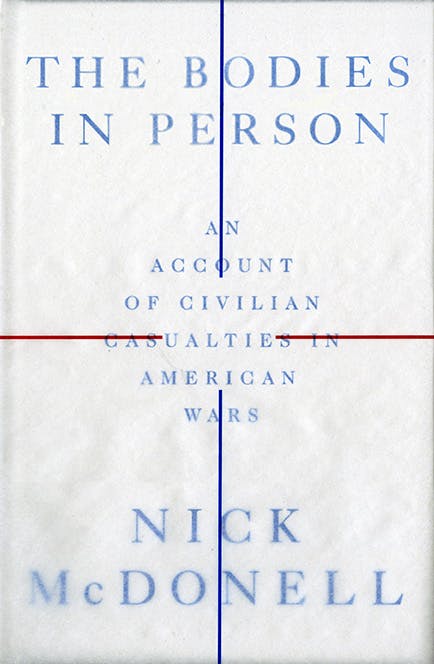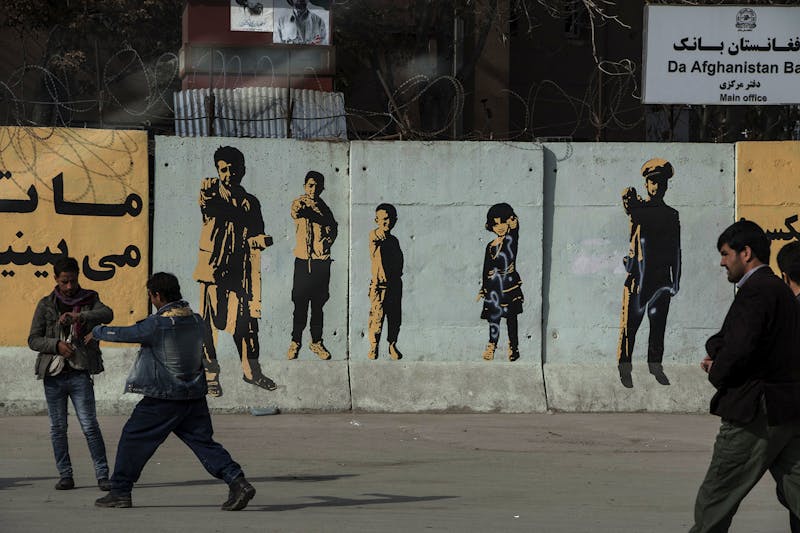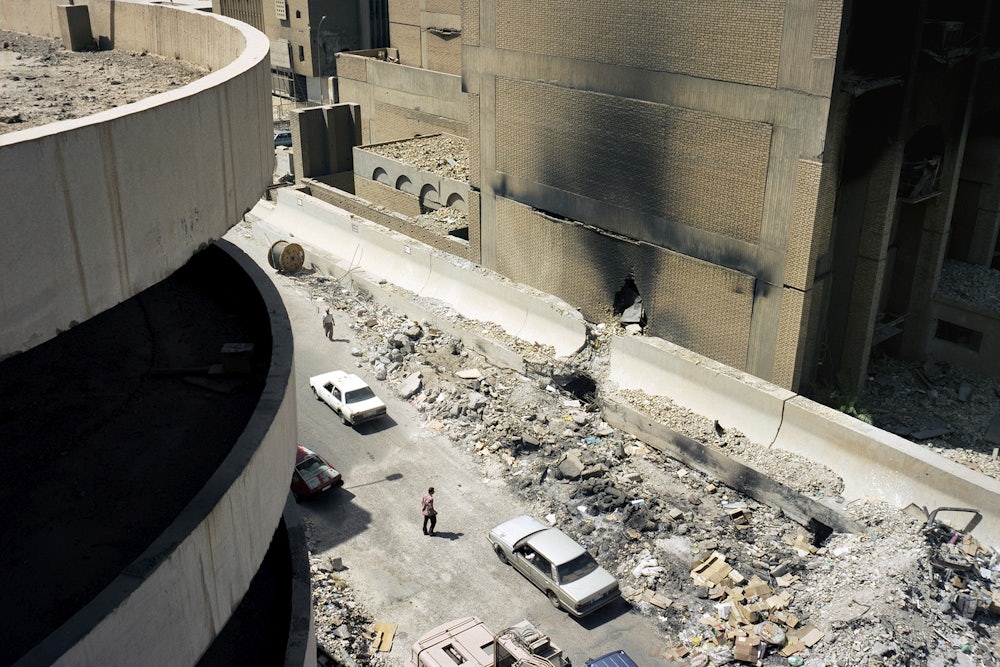The killing of other human beings in war makes graphic an abiding moral dilemma: You might try to make an evil less outrageous, or you might try to get rid of it altogether—but it is not clear that it is possible to do both at the same time. In one of her Twenty-One Love Poems, Adrienne Rich imagines imposing controls on the use of force until it all but disappears: “Such hands might carry out an unavoidable violence / with such restraint,” she writes, “with such a grasp / of the range and limits of violence / that violence ever after would be obsolete.” Yet the lines contradict themselves: If violence is inevitable, however contained or humane, it is not gone.
Nick McDonell’s striking new book about America’s forever war, The Bodies in Person, is a call to contain or minimize one kind of outrageous violence: the killing of civilians in America’s contemporary wars, fought since 9/11 across an astonishing span of the earth. At a moment when Donald Trump has relaxed controls on American killing abroad even beyond what McDonell chronicles and our long-term proxy war in Yemen has broken into gross atrocities—like the Saudi air strike that killed scores of civilians in early August this year—it is a pressing theme. And McDonell’s appeal for Americans not only to attend more to the military excess of the war but also to bring down its civilian toll in the name of the country’s own founding ideals is nothing if not noble.

Pulsating with attention to moral principle, McDonell’s approach to this grisly reality is also highly personal. In his reporting, he restores the identities of civilian victims. “The first step away from a person’s name is the first step toward killing him,” he observes. He gives voice to misgivings that lurk beneath the surface of American consciousness, close enough to cause trouble but submerged too far to break through without help. Instead of explaining the world-historical setting of our wars or presenting another gritty narrative of soldiering abroad, McDonell is interested in how the military thinks, constantly asking our soldiers and their leaders hard moral questions. And yet, fixated on the range and limits of violence, he neglects to ask why our country treats it as unavoidable in the first place.
McDonell comes to the subject of American war as a disillusioned member of his country’s elite. He first became known as a prep school novelist, starting with the publication in 2002 of his smash hit Twelve, composed when he was only 17 years old and still a student at Riverdale Country School in New York. He wrote what he knew: Park Avenue apartments with absentee parents and posh drug dealers. This was the scene in which McDonell set a crime thriller, later made into a film with Kiefer Sutherland. It was both an ambitious undertaking and a remarkably insular vision.
After his years as a Harvard undergrad, McDonell must have concluded that he wanted to learn about more of the world. His third novel, An Expensive Education, marked a transition. Set partly in Somalia, it was still populated by young American elites, but the characters show their growing awareness of the global system of exploitation upon which their own privilege rests. They continent-hop, enjoying their position while also indulging in caustic irony from the top; they amuse themselves without believing anymore in the “stifling orthodoxies” of America’s “ill-conceived experiment in liberty.” The novel marked McDonell’s own evolution along the same lines: “I didn’t always think this way,” McDonell declares at the beginning of The Bodies in Person. “Halfway through my life my country went to war abroad.”
The realities of America’s global presence began to hit home for McDonell as he traveled the world, giving up fiction for reportage, but still equipped with a novelist’s sensibility and style. Afghanistan and Iraq have been his destinations, as he has embedded with ordinary soldiers and engaged in dialogue with higher-ups in the chain of command. Nearly a decade ago, McSweeney’s brought out his nonfiction book The End of Major Combat Operations, a disquieting look at America’s earliest attempt to withdraw with honor from the quagmire it created in Iraq. After a stint at the University of Oxford, McDonell wrote a book of political theory on nomads and their lack of representation in the international system of states. But America’s war kept drawing him back to the field and to the stifling orthodoxies of those who wage and support it.

American elites have, of course, discovered their country’s wars in prior generations. Fiction about and reportage on the moral realities of American conflict have long been a staple of the publishing industry, as generations of writers have dramatized the commitment of the soldiers while also offering skepticism about the missions on which they have been sent. “As if anyone needs another lyrical American war story,” one of McDonell’s cutting footnotes rightly observes, “when Michael Herr’s Dispatches is in every guesthouse from Kerada to Taimani.”
Like Herr’s and other earlier books, The Bodies in Person works through a series of narrative set pieces: McDonell witnesses the violence itself and studies its various aftermaths, like a seismologist traveling to assess the damage of an earthquake at various ranges from the epicenter. He movingly narrates the death of “Sara,” a young Iraqi girl from Tikrit who has been recuperating after a lifesaving operation, only to be killed by a bomb meant for the ISIS stronghold across the street. Like much prior literature in this vein, McDonell’s book recalls his own firsthand experiences, as he recounts his interactions through “fixers” with ordinary people in one scene, and then tells of jumping a helicopter to an undisclosed location in southern Afghanistan to observe American forces target and kill an enemy.
But through these stories, McDonell is preparing a very specific moral inquiry: How much should Americans contain their violence? Inside the computerized room where the group executes an air strike, McDonell surveys the protagonists, putting a human face on a general and his subordinates (and contractors). If every victim deserves a proper name, those who perpetrate their deaths are named too. These are troops who follow orders, assuming they are just, tolerating civilian fatalities as collateral damage; McDonell, outraged, wants to probe whether they are right to do so, and poses deliberately naive questions. “I’m trying to figure out in my own head,” he tells Callie, a private contractor from Missouri, “whether it is appropriate sometimes to kill people to get what we want.”
According to international law, it is. You can never aim at civilians, the law says. But it is not against the rules to kill civilians “collaterally,” so long as doing so is not out of proportion to the concrete and direct military aim, and so long as you take precautions to avoid or minimize harm. Given the consensus around this vague rule, for better or worse, the question is not whether this rule makes sense, but what it means in operations on the ground. What counts as disproportionate? And who decides? The law does not specify what number of civilian deaths counts as too many to allow attack. It all depends on what the military aim is—and who makes the calculation of how much harm is too much.
McDonell doesn’t delve into these questions as legal matters (he dismisses “legalese” at one point) but looks at how American policy defines acceptable violence—the killing of enemies and even civilians in the bargain, just not too many. He is especially concerned, it turns out, with how much of the decision-making is left to personnel on the ground, as he investigates the so-called Non-Combatant Casualty Cutoff Value (NCV)—the maximum number of civilians likely to be killed before troops have to ask Washington for permission to strike. This number was, according to McDonell’s reporting, 20 during the heat of the Iraq counterinsurgency, ten in Iraq more recently, ten in Syria during the campaign against the Islamic State, and zero in Afghanistan, after a higher number stoked popular outrage and anti-government protests.
Stretches of The Bodies in Person examine how the United States manages the optics of war, notably through policies that undercount collateral deaths. As a much-noted New York Times Magazine article by Azmat Khan and Anand Gopal last fall detailed, and as McDonell confirms, part of the callousness of American policy has been that it trivializes the scope of the damage after the fact. McDonell also covers the activities of the “Civilian Casualty Mitigation Team,” engaged in the macabre work of “consequence management” when civilians are injured or killed. A disturbing but fascinating system has been erected by the United States to offer payments for “solace” to next of kin, without taking blame for the deaths. “They don’t necessarily imply responsibility,” one lawyer tells McDonell. All they say is, “we’re very sorry this has happened.”
McDonell’s ultimate worry is not exactly that the number of civilians who die in America’s war is too high; it is that any civilians die at all. Human life, he reasons, is equally valuable, no matter where its bearer breathes and toils, and the United States should therefore set the NCV at zero. America’s current use of the NCV, allowing a certain number of civilian casualties, makes American lives “more valuable than others, which is contrary to the American axiom that all men are created equal.” McDonell dramatizes the facts of American carnage in Afghanistan and Iraq so powerfully that it’s difficult to criticize his sentiments.
But as the main conclusion of The Bodies in Person, this seems wrong. All policies, including those affecting Americans alone, value lives differently. And as McDonell himself reports, the NCV is already at zero in Afghanistan. Setting it there has by no means ended the bloodshed but has only required units to seek permission from a higher authority before they incur collateral damage. Last year alone, over 10,000 civilians were killed or wounded there, according to a United Nations report. And it’s hard to imagine that any army could completely avoid harming noncombatants while engaged in a conflict. The only way to ensure that no civilians are killed is to end this war altogether—something McDonell, like other American elites, is not ready to demand.
McDonell’s chief mistake may lie in focusing on civilian death as the source of the most serious immorality of American war in the first place. After all, in war, troops die too, and calls to contain violence against civilians (or combatants) in war could function unexpectedly to make war more humane and, therefore, more likely to last longer. Indeed, asking for war without collateral damage is like asking for policing without brutality: It would not tend to end it, but to perfect it as a form of control and surveillance. We don’t know enough about how precisely changes in the NCV in Afghanistan have altered the war. But, even if drones are less and less likely to make mistakes, we do know that on the ground ordinary Afghans complain that their presence above is felt as an oppressive menace. Calling for Americans to kill only the enemy, which is what the military is already trying to do, could polish the moral sheen of that menace.
The containment and minimization of violence in America’s war, particularly when it comes to civilian death, have only made it harder to criticize America’s use of force in other countries. As McDonell rightly puts it in an email to the military, “it’s clear that the U.S. has the most robust CIVCAS [civilian casualties] avoidance policy and process in the world (and in history).” And he records Barack Obama explaining, in justification for his new form of light-footprint war:
People, I think, don’t always recognize the degree to which the civilian-casualty rate, or the rate at which innocents are killed, in these precision strikes is significantly lower than what happens in a conventional war.
For this very reason, many of the Americans McDonell interviews think they are fighting a moral war. One of his sources, a colonel, assures him that U.S. policy is “about just not wantin’ to hurt civilians.” “I mean,” he pronounces, “we take our values with us when we go to war.” The policy of avoiding civilian casualties allows the United States to present warfare as a form of virtue, especially to the extent it is increasingly civilian-friendly.
This narrative has only been growing stronger in recent years. Over the second half of Obama’s presidency, the United States moved away from the large ground campaigns on whose final stages much of McDonell’s narrative centers. Instead, the military has lately turned to deadly policing from the air and the deployment of tiny bands of special forces, which America sent to a full three-quarters of the countries of the world last year. Even while Trump has relaxed applicable guidelines for his forces and tolerated the atrocious conduct of America’s Saudi allies in Yemen, he has maintained a twilight war with few boots on the ground or none. To an unprecedented extent, this novel form of war is defined by its attention to the “humanity” of how it is fought.
Which brings us back to the crux of Adrienne Rich’s poem. Is the trouble that there is not enough restraint, or is it the practice of war (or at least this war) itself? The more containment succeeds—leading to less and less objectionable violence, fewer atrocities, and lower body counts, not merely on the American side but also among civilians caught up in the fray and among legitimate military opponents—the more likely it is that the war will continue indefinitely. What if its worst feature is not collateral death, or even violence, but an attempt at global control and ordering that no one opposes?
Lots of care is needed in considering this possibility, yet it is ultimately even more disturbing than the reality that America must do even better counting its casualties and preventing collateral harm. What if, to be blunt, the deepest moral problem with contemporary American war is not its inhumanity but its existence? What if the Pentagon is outrageously mistaken in the details and is outrageously undercounting civilian deaths, but is also entirely correct that it is fighting the most humane war in history? And what if the deepest moral problem with it is not its failures of containment, but the fact that its increasing nonviolence is part of its endlessness and the global hegemony it enforces?
If McDonell doesn’t ask these questions, it may be because of his nostalgia for the standard beliefs of American elites, whose novelist he once seemed to be grooming himself to become. America was supposed to be founded on a new idea—the universal equality of human beings. Yet it has been engaged in global rule for a while now. “The only non-combatant casualty cutoff value consistent with our values is zero,” McDonell insists, even as he knows both that those values have never guided the U.S. military in a conflict, and that noncombatants have been treated much worse in every American war to date. “Insistence on equality, despite its piercingly slow entry onto the rolls of law, is the most powerful aspect of our experiment,” McDonell adds in the vein of conventional American exceptionalism.
McDonell is aware that this is overoptimistic, but he concludes that, because the “worst crimes stem from a failure of imagination rather than any evil particular to our kind or time or nation,” narratives like his own might change the equation someday. I hope so. But if they do, they will need to reckon with the fact that we confront our endless war only partially when we focus on the civilian death and injury (or, for that matter, death and injury generally) that it involves. If this war can last forever because it is so humane—and fought for ends of control and surveillance rather than with the aim of killing enemies to break the will of the other side—then making it less deadly and more humane may extend it only more.
